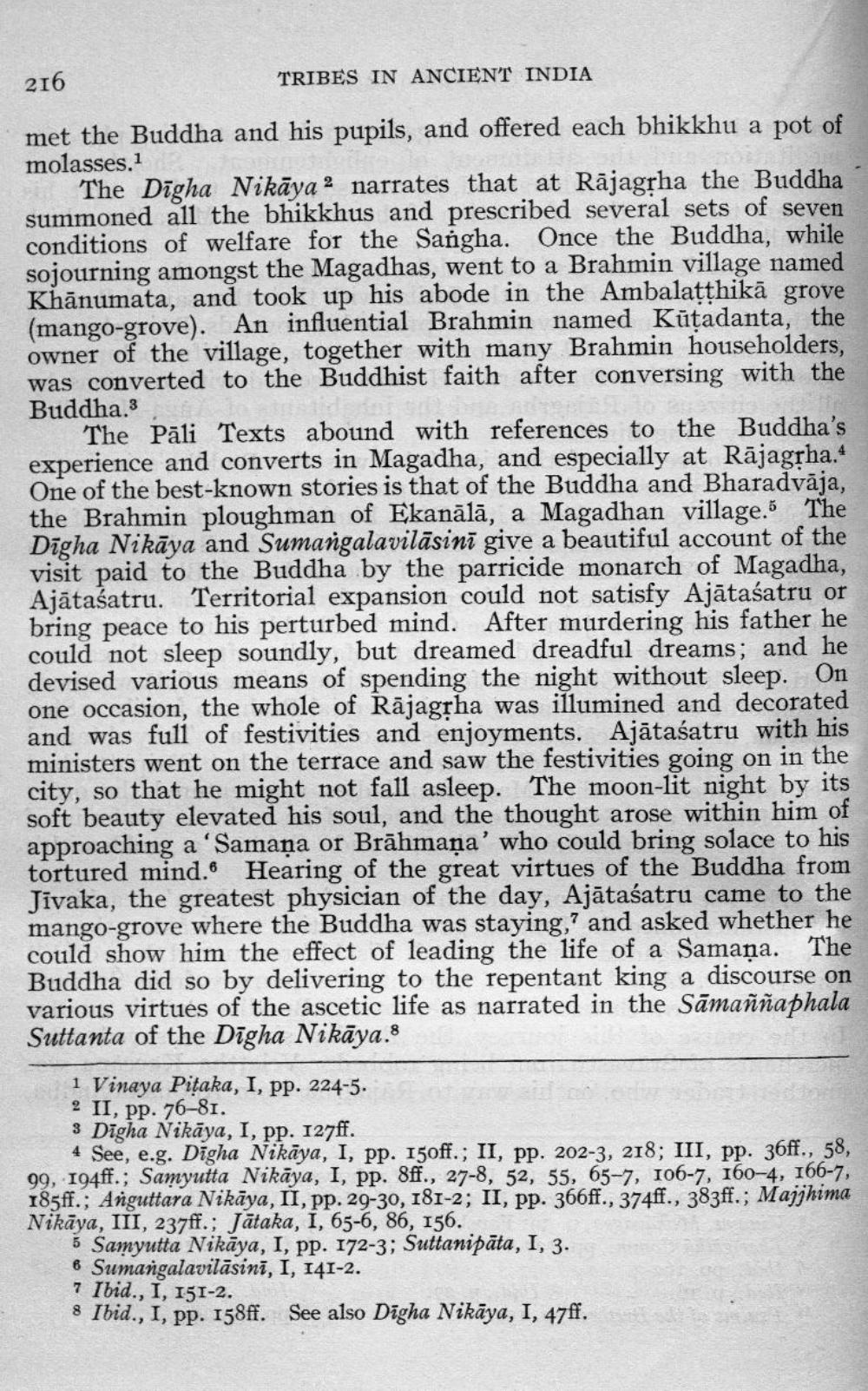________________
TRIBES IN ANCIENT INDIA
216
met the Buddha and his pupils, and offered each bhikkhu a pot of molasses.1
The Digha Nikaya 2 narrates that at Rajagṛha the Buddha summoned all the bhikkhus and prescribed several sets of seven conditions of welfare for the Sangha. Once the Buddha, while sojourning amongst the Magadhas, went to a Brahmin village named Khanumata, and took up his abode in the Ambalaṭṭhikā grove (mango-grove). An influential Brahmin named Küṭadanta, the owner of the village, together with many Brahmin householders, was converted to the Buddhist faith after conversing with the Buddha.3
5
The Pali Texts abound with references to the Buddha's experience and converts in Magadha, and especially at Rajagṛha.* One of the best-known stories is that of the Buddha and Bharadvaja, the Brahmin ploughman of Ekanālā, a Magadhan village. The Digha Nikaya and Sumangalavilasini give a beautiful account of the visit paid to the Buddha by the parricide monarch of Magadha, Ajātaśatru. Territorial expansion could not satisfy Ajataśatru or bring peace to his perturbed mind. After murdering his father he could not sleep soundly, but dreamed dreadful dreams; and he devised various means of spending the night without sleep. On one occasion, the whole of Rajagṛha was illumined and decorated and was full of festivities and enjoyments. Ajataśatru with his ministers went on the terrace and saw the festivities going on in the city, so that he might not fall asleep. The moon-lit night by its soft beauty elevated his soul, and the thought arose within him of approaching a 'Samana or Brāhmaṇa' who could bring solace to his tortured mind. Hearing of the great virtues of the Buddha from Jivaka, the greatest physician of the day, Ajātaśatru came to the mango-grove where the Buddha was staying, and asked whether he could show him the effect of leading the life of a Samana. The Buddha did so by delivering to the repentant king a discourse on various virtues of the ascetic life as narrated in the Samaññaphala Suttanta of the Digha Nikaya.8
1 Vinaya Pitaka, I, pp. 224-5. 2 II, pp. 76-81.
3 Digha Nikaya, I, pp. 127ff.
4 See, e.g. Digha Nikaya, I, pp. 150ff.; II, pp. 202-3, 218; III, pp. 36ff., 58, 99, 194ff.; Samyutta Nikaya, I, pp. 8ff., 27-8, 52, 55, 65-7, 106-7, 160-4, 166-7, 185ff.; Anguttara Nikaya, II, pp. 29-30, 181-2; II, pp. 366ff., 374ff., 383ff.; Majjhima Nikāya, III, 237ff.; Jātaka, I, 65-6, 86, 156.
5 Samyutta Nikaya, I, pp. 172-3; Suttanipata, I, 3.
6 Sumangalavilāsini, I, 141-2.
7 Ibid., I, 151-2.
8 Ibid., I, pp. 158ff. See also Digha Nikaya, I, 47ff.




